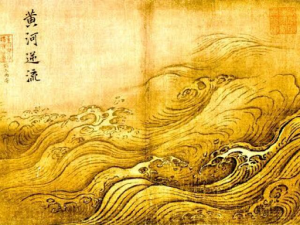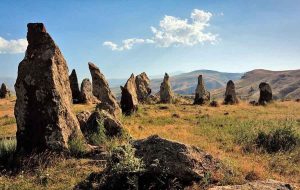 What reality lay behind ancient China’s flood legends? Who was the Yellow Emperor? Who was Archer Yi, what was his vermilion bow, how did he shoot down nine of ten suns, and why were there ten suns in the first place?
What reality lay behind ancient China’s flood legends? Who was the Yellow Emperor? Who was Archer Yi, what was his vermilion bow, how did he shoot down nine of ten suns, and why were there ten suns in the first place?
We now know the answers to these and other questions about ancient China. These answers can lead us to a new understanding of Chinese history, of the worldwide Bronze Age catastrophes, and of the history of climate change. (Ma Yuan, The Yellow River Breaches Its Course, Wikimedia Commons)
Tags: Ancient China, archaeoastronomy, Archer Yi, Bronze Age catastrophes, climate change, Jingwei bird, Liangzhu, Longshan, Mars, myth, Shang, stone ladders, Taidong, Taosi, Teotihuacan, tsunamis, Velikovsky, venus, Western Zhou, Xia, Yellow Emperor, 灾难和气候变化中国古代
 Karahunj (Zorats Karer) is an ancient site in southern Armenia that contains more than 230 large stones, some 37 still standing, arranged in a fashion that has suggested to many observers that it was used for archaeoastronomy. But defining how it was used has remained elusive. Complicating the situation, Karahunj is located near a complex of ancient graves; we do not know who built it; it is difficult to ascertain exactly when the stones were set up; and some 85 of them have holes drilled through them that researchers have suggested might be used for sighting celestial objects, but other researchers think this unlikely because they would have been too imprecise.
Karahunj (Zorats Karer) is an ancient site in southern Armenia that contains more than 230 large stones, some 37 still standing, arranged in a fashion that has suggested to many observers that it was used for archaeoastronomy. But defining how it was used has remained elusive. Complicating the situation, Karahunj is located near a complex of ancient graves; we do not know who built it; it is difficult to ascertain exactly when the stones were set up; and some 85 of them have holes drilled through them that researchers have suggested might be used for sighting celestial objects, but other researchers think this unlikely because they would have been too imprecise.
Nonetheless, there is a rather simple explanation of the stones of Karahunj. But to grasp it, one must become aware of the compelling new evidence for and reinterpretation of
Tags: ancient history, archaeoastronomy, Armenia, Great Serpent Mound, Karahunj, Taosi, Velikovsky, venus
 What reality lay behind ancient China’s flood legends? Who was the Yellow Emperor? Who was Archer Yi, what was his vermilion bow, how did he shoot down nine of ten suns, and why were there ten suns in the first place?
What reality lay behind ancient China’s flood legends? Who was the Yellow Emperor? Who was Archer Yi, what was his vermilion bow, how did he shoot down nine of ten suns, and why were there ten suns in the first place?
